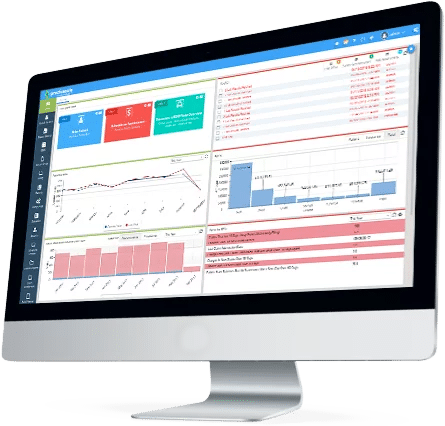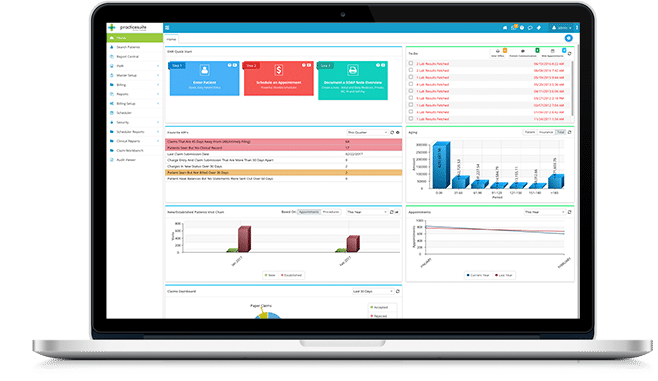The PracticeSuite Advantage
Cloud-based medical billing platform
Integrated with EHRs in 65+ specialties
A single sign-on for multiple practices
Inter-office communications with task assignment
Work rejections, denials, and post payments across all clients on one dashboard
Electronic UB04 & Workers Comp* claims billing
Create a sandbox account and try out the software before buying
Your Success is Our Success
Get your own dedicated customer success specialist who will stick around to help you not only on day one, but also day 1,001 and beyond.
Zero-Competition
PracticeSuite supports Billing Services on our software. We garuntee to never take a provider from our customers!
Win More
PracticeSuite refers business to billing companies on our platform and help you win the business!
Grow Together
Marketing opportunities available and we will include you in a Software Revnue Share Plan.
#1 RCM Software to Drive Growth
Enterprise Claims Management Workflow
Handle rejections, denials, and payment posting across all clients on one dashboard. Mass claim correction.
Promote Your Brand
Your clients can see your logo in the software.
A Complete Practice Solution
Scheduling, Billing, Telehealth/EHR, e-Payments w/ auto-posting, Reminders, Patient portal, and more.
Comprehensive Specialty Needs
155 Billing Specialties, 60+ clinical specialties, UB04 & Workers Comp
RCM & Financial Reporting
A/R Reports by Payer, Guarantor and Practice Financial Summary
A Cental Billing Office
Single Sign On (SSO) multi-practice access across all client accounts. High level practice-health KPI dashboards.

Revenue Cycle Management Software
Healthcare providers are responsible for several multifaceted business operations, including financial and administrative tasks. Because there’s so much involved in these processes, more and more providers are turning to revenue cycle management software for help. This software is designed to manage every aspect of the healthcare revenue cycle from patient scheduling to final payment.
RCM software—RCM meaning “revenue cycle management”—streamlines the financial process that healthcare providers use for revenue management. The process begins with a patient’s first contact with the healthcare provider and continues until the provider closes the patient’s account.
RCM companies provide these solutions. Leveraging advanced technology, they help eliminate inefficiencies and reduce administrative overhead by developing comprehensive software systems. These systems include features such as patient registration, insurance verification, and payment collection.
Revenue cycle management software offers several key benefits to healthcare providers.
First, it improves cash flow by shortening the revenue cycle. The software enables providers to efficiently manage patient appointments, verify insurance eligibility in real-time, and expedite reimbursements. The reduction in time from patient service to payment improves the financial stability of the provider.
The software also reduces the risk of errors and rejections. It includes intelligent features such as coding assistance and automatic alerts for potential errors. These features allow providers to submit accurate claims the first time, thereby reducing rejections and denials, as well as the need for time-consuming claim resubmissions.
Third, RCM software boosts patient satisfaction. A streamlined and transparent billing process makes it easier for patients to understand their financial responsibility. Automated reminders can help patients make timely payments, which lowers the risk of surprise bills or collections and can lead to improved patient satisfaction.
In addition, this software provides valuable insights through analytics. It can track key metrics such as denial rates, days in accounts receivable, and cost-to-collect. These insights enable providers to identify bottlenecks and implement strategies to improve the efficiency and profitability of their operations.
What is the Revenue Cycle in Healthcare
So what is the revenue cycle in healthcare? In healthcare, the revenue cycle is the process by which healthcare organizations track patient revenue, starting from their initial appointment or encounter with the system up to the final payment of the balance. It involves a series of complex processes that include coding, charge capture, claim submission, and patient collections.
The revenue cycle’s importance to healthcare cannot be overstated. It ensures organizations receive compensation for the services they provide. The cycle also helps companies improve their efficiency, decrease the time to payment, and enhance patient satisfaction by making the billing process more transparent.
However, this cycle can be time-consuming and fraught with error. By prioritizing revenue cycle management, organizations can more easily manage all administrative and clinical functions associated with revenue capture. They can also use revenue cycle management software to automate and streamline many aspects of the cycle.
For example, consider a mid-sized healthcare provider dealing with high claim denials. They’re overwhelmed by the manual processes involved in tracking, coding, and submitting claims, and so they decide to implement a cycle management solution. This software automatically verifies patient information and codes the diagnoses and procedures accurately, significantly reducing errors.
In another example, a small outpatient practice might struggle with collecting patient payments, so they take the plunge and invest in revenue cycle management software with a built-in patient portal. Patients receive automatic reminders about upcoming bills and are able to pay their bills online through the patient portal. As a result, the clinic sees a 30% increase in timely payments.
These examples demonstrate the value of RCM software and the various ways it can be used to improve the revenue cycle in healthcare.
RCM Process
Revenue cycle management in healthcare is vital to the success of healthcare companies. The RCM process streamlines billing, increases reimbursement rates, and much more. Here are the key steps involved:
- Pre-Registration: This is the first stage in the RCM process. Patients make appointments and provide their demographic and insurance information. During pre-registration, the patient’s eligibility and insurance coverage are verified to avoid any issues with insurance claims down the line.
- Registration: At this stage, patients provide necessary personal and medical history information that could affect their treatment or claims process. This step is crucial for accurate patient identification and record-keeping.
- Charge Capture and Coding: After the patient’s visit, medical coders translate the services provided, diagnoses, and procedures into universal medical codes. These coded claims are necessary for billing insurance companies and allow for appropriate reimbursement.
- Claim Submission: Claims submission involves submitting the coded claims to insurance companies for reimbursement. The claims must be error-free and compliant with the insurance company’s guidelines to avoid denial or delay in payments.
- Remittance Processing: At this point in the revenue cycle management process, the provider receives payment from the insurance company. Any denials, underpayments, or overpayments are identified and addressed.
- Insurance Follow-Up and Denial Management: If an insurance claim is denied, the cause of the denial is investigated, and the claim is corrected and resubmitted. This ensures maximum reimbursement.
- Patient Collections: Finally, any remaining balance after insurance payments are collected from the patient. It’s important for healthcare providers to have a clear and convenient payment process to promote timely collections.
Given the complexity of the RCM process, many organizations partner with healthcare revenue cycle companies to gain access to valuable revenue cycle management services. These companies offer end-to-end RCM services, utilizing a blend of technology and human expertise to simplify the revenue cycle.
Some of the top RCM companies in the USA include Epic Systems Corporation, McKesson Corporation, and GE Healthcare. These companies offer comprehensive RCM solutions that include everything from electronic health records and medical billing software to coding services and patient collections.
Revenue Cycle Management Companies
Healthcare revenue cycle companies, also known as revenue cycle management companies, play a pivotal role in the healthcare industry. They provide robust services and solutions designed to improve the financial health of healthcare organizations. They help organizations develop innovative strategies to handle all aspects of revenue cycle management.
The top healthcare revenue cycle management companies offer several key services, including:
- Medical Coding and Billing: These companies employ professional coders who accurately translate patient records into standard codes used for billing insurance companies. They also handle the billing process, ensuring that claims are correctly submitted and promptly paid.
- Claim Management: Claim management involves overseeing the claim submission process and making sure that claims are error-free and compliant with insurance guidelines.
- Patient Registration and Scheduling: Revenue cycle companies also offer software solutions that handle patient scheduling, registration, and intake. This ensures a smooth and efficient patient experience from the first point of contact.
- Insurance Verification and Eligibility Checks: Prior to patient appointments, these companies verify patient insurance details and check eligibility to prevent claim denials due to incorrect information or lack of coverage.
- Patient Collections: Cycle management companies handle the patient collections process, providing clear and timely bills, setting up payment plans, and following up on overdue accounts.
For instance, the revenue cycle systems offered by companies often include features like electronic health records (EHR), computerized physician order entry (CPOE), and analytical reporting tools. These solutions provide a unified platform where all stages of the revenue cycle can be managed.
RCM Systems
What is RCM in medical billing? The RCM meaning in medical terms stands for “revenue cycle management.” The need to manage this process effectively has led to the development of various RCM systems and healthcare RCM software. These systems assist providers in managing the complexities of healthcare billing.
When looking for the best RCM software, healthcare providers should consider several key factors:
- Integration With Existing Systems: It’s important to choose software that integrates seamlessly with your existing systems. The ideal RCM software will allow for the smooth exchange of information, reducing manual data entry and increasing efficiency.
- Functionality: Your system of choice should meet your unique needs, whatever those happen to be. Core functionalities typically include patient scheduling, insurance eligibility verification, and claims management. However, additional features like contract management can also be beneficial.
- Regulatory Compliance: RCM tools should adhere to any relevant regulatory changes, including billing rules and coding guidelines, to ensure compliance and minimize claim denials. Compliance with data security standards, such as HIPAA, is also critical to protecting patient information.
- Ease of Use: The software interface should be user-friendly, allowing staff to easily navigate the system and perform tasks efficiently. Look at what’s offered in terms of training, and consider the steepness of the learning curve.
- Vendor Support: Robust customer support from the vendor is key. Look for vendors that provide 24/7 support and ongoing training resources.
- Cost: Costs can vary widely among different RCM systems, so it’s important to understand the pricing model. Some vendors charge a flat monthly fee, while others charge a percentage of the provider’s revenue.
PracticeSuite’s revenue cycle management software is among the most comprehensive on the market. It offers medical billing services, real-time transparency, and more. With PracticeSuite, you can make your patients’ lives easier while maximizing your ROI.



